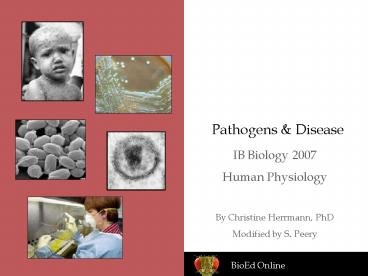Pathogens - PowerPoint PPT Presentation
1 / 13
Title:
Pathogens
Description:
Infectious diseases are responsible for a quarter to a third of all ... Responsible for: Athlete's foot, ringworm. www.BioEdOnline.org. BioEd Online. Animals ... – PowerPoint PPT presentation
Number of Views:133
Avg rating:3.0/5.0
Title: Pathogens
1
Pathogens Disease
- IB Biology 2007
- Human Physiology
- By Christine Herrmann, PhD
- Modified by S. Peery
2
Infectious Diseases as a Cause of Death
- Infectious diseases are responsible for a quarter
to a third of all deaths worldwide. - Infectious diseases account for more than half of
all deaths in children under the age of 5. - Of the top ten causes of death compiled by the
World Health Organization, five are due to
infectious diseases. - The top single agent killers are HIV/AIDS,
malaria and tuberculosis. The other top killers
are lower respiratory infections and diarrheal
diseases, which are caused by a variety of
agents.
3
Infectious Diseases Throughout History
- Infectious agents have probably always caused
disease in humans. - Smallpox has been described in ancient Egyptian
and Chinese writings and may have been
responsible for more deaths than all other
infectious diseases combined. - There is evidence that malaria and poliomyelitis
have existed since ancient times. - In the 14th Century, the bubonic plague, or Black
Death, killed about 20 million people in Europe
alone. - In the 20th Century, the 1918 influenza may have
killed up to 50 million people worldwide - Close to 20 million people have died of AIDS to
date.
Courtesy of CDC Recreated 1918 Influenza virions.
The 1918 Spanish flu killed more than 500,000
people in the United States and up to 50 million
worldwide.
4
Infectious Diseases - Definitions
- Disease a pathological condition of body parts
or tissues characterized by an identifiable group
of signs and symptoms. - Infectious disease disease caused by an
infectious agent such as a bacterium, virus,
protozoan, or fungus that can be passed on to
others. - Infection occurs when an infectious agent
enters the body and begins to reproduce may or
may not lead to disease. - Pathogen an infectious agent that causes
disease. - Host an organism infected by another organism.
- Virulence the relative ability of an agent to
cause rapid and severe disease in a host.
5
Infectious Disease Agents
- Most infectious agents that cause disease are
microscopic in size and thus, are called microbes
or microorganisms. - Different groups of agents that cause disease
are - Bacteria
- Viruses
- Protozoa (Protists)
- Fungi
- Helminths (Flatworms and roundworms)
Courtesy of CDC
6
Bacteria Viruses
- Prokaryotic cells
- Responsible for pneumonia, strep throat,
tuberculosis, cholera, and anthrax - Remember, plenty of bacteria are GOOD and
essential for your survival
- Typical structure protein casing with nucleic
acid inside - Debatable as to living or nonliving- why?
- Reproduce and spread using hosts cellular
machinery and resources - Antibiotics arent effective- why?
- Responsible for flu, AIDS, chickenpox,
hepatitis, SARS
7
Protozoa Fungi
- aka Protists
- Includes multicellular and unicellular organisms
- Most pathogens are unicellular
- Responsible for malaria and sleeping sickness
- Often transmitted by animals
- Often grow on surface/skin
- Can be transmitted by animals, poor hygiene, and
people - Responsible for Athletes foot, ringworm
8
Animals
- aka Helminths, Roundworms, Flatworms, Flukes
- Largest pathogens
- Eggs are ingested through contaminated food,
develop into adults, and reproduce, continuing
infection - Usually damage specific tissues
- Flatworms responsible for tapeworms, liver fluke
(both parasitic) - Roundworms raccoon roundworm disease is latest
scare
9
Transmission of Infectious Diseases
- Agents that cause infectious diseases can be
transmitted in many ways. - Through the air
- Through contaminated food or water
- Through body fluids
- By direct contact with contaminated objects
- By animal vectors such as insects, birds, bats,
etc. - Through openings/cuts in the skin
Courtesy of VOA Chinese students wearing masks
during a SARS outbreak
Courtesy of CDC Aedes aegypti mosquito Known to
transmit Dengue fever
10
How Infectious Agents Cause Disease
- Production of poisons, such as toxins and
enzymes, that destroy cells and tissues. - Direct invasion and destruction of host cells.
- Triggering responses from the hosts immune
system leading to disease signs and symptoms.
Courtesy of CDC Human Immunodeficiency Virus.
HIV-1 virions can be seen on surface of
lymphocytes.
11
Example of an Infectious Disease - Flu
- Acute contagious disease caused by the influenza
virus. - Respiratory tract infection, but symptoms felt
throughout entire body. - Epidemics occur seasonally with low fatality
more deadly pandemics occur several times each
century. - Highly changeable virus that can infect multiple
species, including humans, pigs, and birds. - Concern exists that current avian flu will lead
to a new pandemic.
12
Example of an Infectious Disease - AIDS
- AIDS (Acquired Immune Deficiency Syndrome) is the
disease caused by the virus called HIV (human
immunodeficiency virus). - HIV attacks cells of the immune system and
destroys their ability to fight infection by
other agents. - HIV is spread through the direct exchange of body
fluids. - There is a long period of time from HIV infection
to the onset of AIDS. - Anti-HIV drugs prolong the length and quality of
life, but there is no vaccine or cure for AIDS.
Courtesy of CDC This highly magnified
transmission electron micrographic (TEM) image
revealed the presence of mature forms of the
human virus immunodeficiency (HIV) in a tissue
sample under investigation.
13
Reducing the Spread of Infectious Diseases
- Vaccines
- Antimicrobial drugs
- Good personal hygiene and sanitation
- Protection against mosquitoes
- Quarantine































